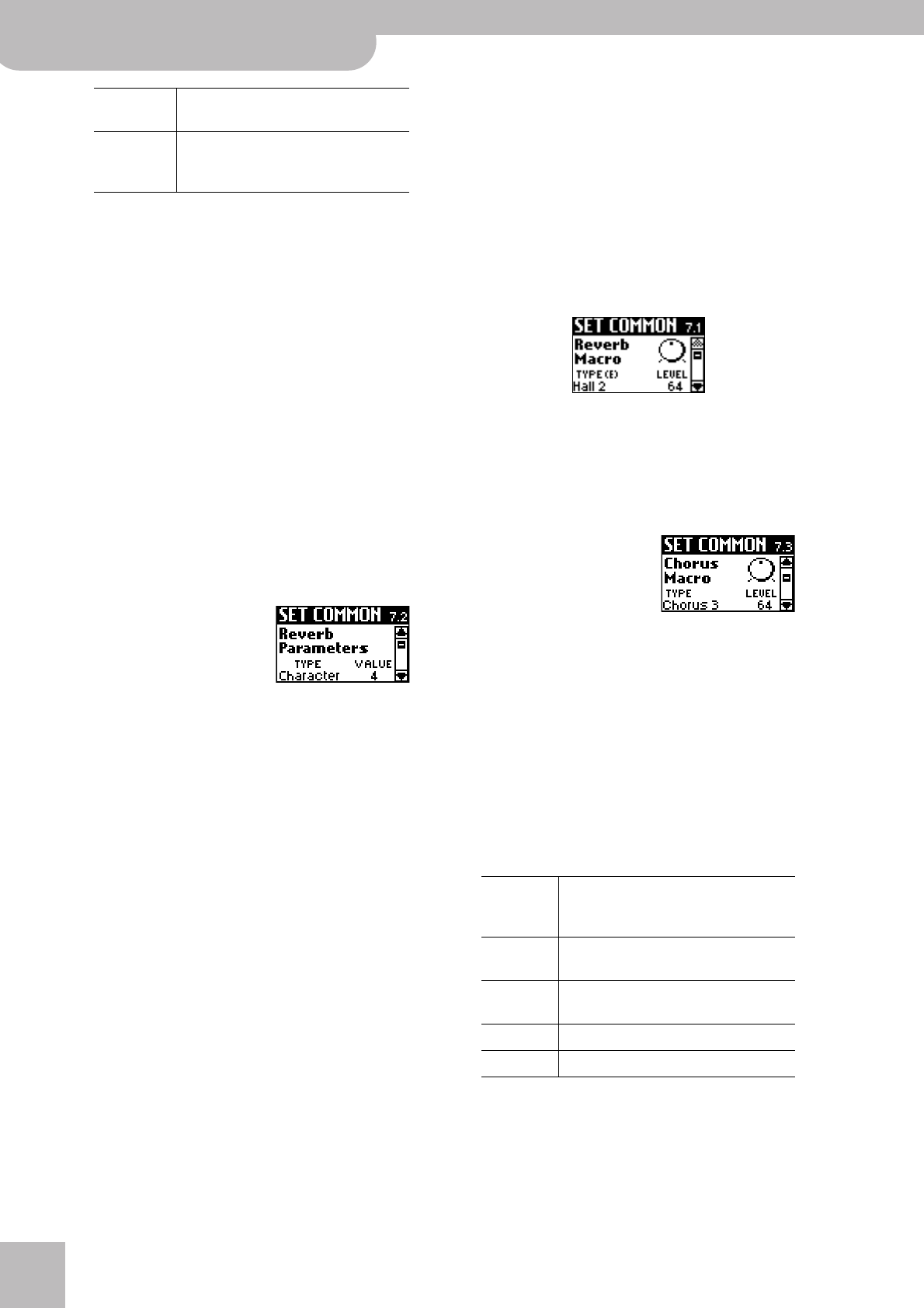
Editing sounds | SET COMMON parameters
56
r
FR-7/FR-5 V-Accordion
Note: Seeing that a delay effect usually only works for one
part, we recommend using the dedicated Delay processor for
echo effects. That way, the reverb effect can be used to
“deepen” the sound field.
(2) Press the [DATA÷ENTER] knob to select the “LEVEL”
parameter, then rotate the [DATA÷ENTER] knob to
set the Reverb processor’s output volume (0~127).
The important thing to remember here is that the
overall reverb volume depends on three things: the
Send level of the various sections, the output level of
the Reverb processor and the setting of the [REVERB]
knob.
If one of them is set to “0”, there will be no reverb. If
the Send level of a section (Orchestra, for example) is
set to “0”, only the selected sound will have no
reverb. Other sections (whose Send value is different
from “0”), however, can still be processed by the
Reverb effect. If the LEVEL parameter on this page is
set to “0”, the Reverb processor is effectively off for
all sections.
7.2 Reverb Parameters
This page contains several
parameters that need to be
selected using the TYPE entry.
Be sure to first select the
parameter you want to change
and then set its value.
(1) If necessary, press the [DATA÷ENTER] knob to select
the “TYPE” parameter, then rotate the
[DATA÷ENTER] knob to select a parameter.
■ Character (0~7)—Character only specifies the Reverb
type you need (see the table above). It does not load preset
values for the Pre-LPF~RevPreDlyTm parameters. Selecting
another Character thus does not reset the other parameter
values to their factory settings. A Macro, on the other
hand, calls up a Reverb type and suitable settings for that
effect.
■ Pre-LPF (0~7)—A low-pass filter can be applied to the
high-frequency range before the signals coming from the
various sections are processed by the reverb. Higher values
make the Send signals darker, which results in a mellower
reverberation. Note that this parameter only applies to the
signals that are sent to the Reverb processor. It does not
alter the sound of the active sections.
■ Time (0~127)—This parameter sets the duration of the
reverb effect. Higher values result in longer reverberation.
■ Level (0~127)—This parameter sets the output volume
of the Reverb processor. It is linked to its namesake on the
“7.1 Reverb Macro Type” page. Higher values result in
louder reverberation.
■ Dly Fback (0~127)—This parameter is only available
when you set Character to “6” or “7”. It specifies the num-
ber of echoes: higher values result in more repetitions.
■ Pre-Dly T. (0~127)—This parameter sets the time inter-
val between the original (“dry”) signal and the onset of the
selected reverb effect. Higher values result in a longer pre-
delay time, simulating a larger reverberant space.
(2) Press the [DATA÷ENTER] knob to select the “VALUE”
parameter, then rotate the [DATA÷ENTER] knob to
set the parameter value (see the indications
between brackets).
If you change one of the above parameter values, an
“(E)” appears next to the “TYPE” name to signal that
you are no longer using the presets of the macro in
question.
If you then select another TYPE, however, your
changes are lost and replaced by the settings of the
newly selected macro.
Note: Simultaneously press the [UP] and [DOWN] buttons to
recall the factory setting for the currently active parameter.
7.3 Chorus Macro Type
Chorus broadens the spatial
image of the sound, adding
richness. You can choose from 8
types of chorus. The “Macro”
label still does what its name
implies. Be aware, however, that there is no “Character”
parameter on page “7.4”.
Note: You can also copy the Chorus (or even all effects) settings
from another Set. See page 64.
(1) If necessary, press the [DATA÷ENTER] knob to select
the “TYPE” parameter, then rotate the
[DATA÷ENTER] knob to select an effect type.
The TYPE parameter on this page is a “Macro” func-
tion, i.e. it recalls suitable preset values for all Chorus
parameters on the “7.4 Chorus Parameters” page. In
many instances, editing only the parameters on this
page is enough.
The available options are:
Note: Seeing that a delay effect usually only works for one
part, we recommend using the dedicated Delay processor for
echo effects. That way, the chorus effect can be used to widen
the stereo image.
(2) Press the [DATA÷ENTER] knob to select the “LEVEL”
parameter, then rotate the [DATA÷ENTER] knob to
set the Chorus processor’s output volume (0~127).
Delay This is a conventional Delay that pro-
duces echo effects.
Panning Dly This is a special Delay in which the
delayed sounds move left and right. It is
effective when you are listening in stereo.
Chorus 1~4 These are conventional Chorus effects
that add spaciousness and depth to the
sound.
FBack Chr This is a Chorus with a Flanger-like effect
and a soft sound.
Flanger This is an effect that sounds somewhat
like a jet airplane taking off or landing.
Short Delay This is a delay with a short Delay time.
ShortDly FB This is a short delay with many repeats.


















